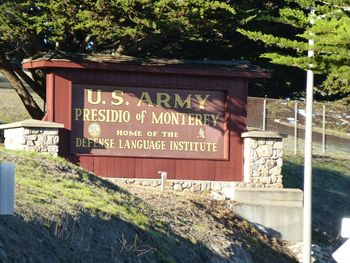Presidio of Monterey (2)
|
Presidio of Monterey (2) (1846-1866, 1902-Present) - A U.S. military reservation established near the site of captured El Castillo de Monterey in 1846 at the beginning of the Mexican War. Initially named Fort Stockton after Commodore Robert F. Stockton and renamed Fort Mervine after Navy Captain William Mervine who led the initial landing party. Later named Fort Halleck (3) for Lieutenant Henry W. Halleck the engineer charged with completing construction. Abandoned between 1866 and 1902. Reactivated in 1902 and renamed Presidio of Monterey in 1904. Active U.S. military installation. Also known as Fort Savannah (1), Post at Monterey, Monterey Ordnance Depot, Monterey Barracks and Ord Barracks.
The Mexican Period (1822-1846) On 20 Oct 1842 a U.S. warship, under the mistaken impression that a state of war had been declared between the United States and Mexico, landed at Monterey and claimed the Mexican fortification, El Castillo de Monterey, for the United States. The Castillo was renamed Fort Gatesby by the Americans but only for a day. The mistake was recognized and apologies were given and the American ship sailed away. The incident was referred to as the great mistake. At the end of the Mexican Period the Presidio of Monterey and the El Castillo de Monterey were both in a ruined condition and had no military value.
The American Period (1846-Present)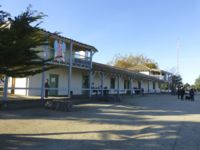 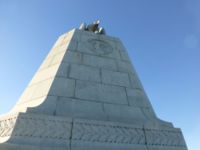  The Mexican War was declared by the U.S. Congress on 11 May 1846 in response to a Mexican attack on U.S. troops in Texas. The declaration of war opened the door for American occupation of California. The American period began when American naval ships entered Monterey Bay and Navy Captain William Mervine landed and had the American flag raised over the Monterey Customs House. The U.S. forces did not use the old El Castillo de Monterey site for their gun batteries because it was clearly vulnerable to land attack from high ground behind it. The U.S. forces, first Navy and later Army, built their fort on that high ground behind the old Castillo on Presidio Hill as the first U.S. fortification. Construction of the new fort at Monterey was begun by Naval personnel almost as soon as the forces had landed on 7 Jul 1846. These forces began the construction of a gun battery with three 42-pounder cannons and a two story hewn timber blockhouse. The Naval Fort was initially named Fort Stockton after Commodore Robert F. Stockton and renamed Fort Mervine after Navy Captain William Mervine who led the initial landing party. On 28 Jan 1847 Company F of the 3rd U.S. Artillery landed at Monterey and took over construction of the new fortifications. Three of the officers with this company were West Point graduates and would later become top generals in the U.S. Civil War, 1st Lt. Edward O.C. Ord, 1st Lt. William T. Sherman and 1st Lt. Henry W. Halleck. Lt. Halleck was the junior lieutenant by rank and possibly the most experienced fort builder and it fell to him to supervise the completion of the fortification. The resulting fortification was a redoubt in the form of a bastion that overlooked the harbor with twenty 24-pounder cannons and four 8 inch mortars. In back of the redoubt Halleck built a large stone 75' by 25' ordnance storage building to contain all the ordnance shipped to Monterey. The Mexican War ended in 1848 and soon after the California Gold Rush began. Most of the Infantry companies were mustered out and most of Company F, 3rd U.S. Artillery had deserted for the gold field. In August1852 the last artillery troops left the post leaving it an ungarrisoned ordnance depot.
U.S. Civil War (1861-1865)In 1865 the post was temporarily regarrisoned by elements of the 6th California Volunteer Infantry and the 1st Battalion California Native Cavalry. Two log huts were erected to house the troops and the post was renamed Ord Barracks. The troops departed in 1866 and left the post in the hands of a volunteer caretaker. On 23 Nov 1866 an executive order and subsequent survey established a 158 acre military reservation. Post Civil War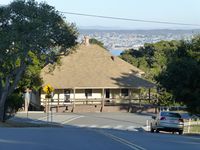   On 9 Sep 1902 the 15th U.S. Infantry was ordered to Monterey to build a post at the Monterey Military Reservation to house the regiment and a squadron of cavalry. The post name reverted to Ord Barracks. In 1904, General Order No. 142 dated 30 Aug 1904, specified that the name of the reservation would return to the original name, the Presidio of Monterey.
Before World War I the post hosted a school of musketry and then a school for cooks and bakers from 1914 to 1917. Between WWI and WWII the post was garrisoned by two squadrons of the 11th U.S. Cavalry and two battalions of 76th U.S. Field Artillery who remained at the post until 1940. In the 1930s parts of the aging post were refurbished by the Civilian Conservation Corps (CCC) who as one of their project leveled the sloping parade ground creating two levels. A Civilian Military Training Camp (CMTC) was built on the upper post and operated as an officer training camp for civilians between 1932 and 1940. During World War II the Presidio was a reception center for inductees. It was deactivated in 1944 but reactivated in 1945 to serve as a training center for occupation forces being sent to Japan. In 1946 the Army Language School was established at the Presidio and that school became the present day Defense Language Institute (DLI) in 1963. The language school now is designated Defense Language Institute Foreign Language Center (DLI-FLC). The language center serves all components of the Department of Defense and some other agencies.
Current Status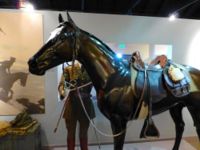 Active military reservation, home of the Defense Language Institute, Presidio of Monterey, Monterey County, California. Open access to historic sites and memorials area. Sloat Memorial and Father Junipero Serra Memorial.
USGS Geographic Names Information System (GNIS) Database Entry: 2512439
Sources:
Links:
Visited: 29 Nov 2013, 23 Nov 2012 | ||||||

